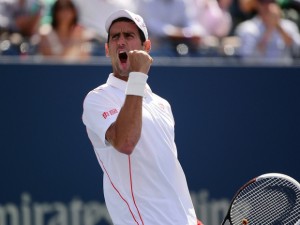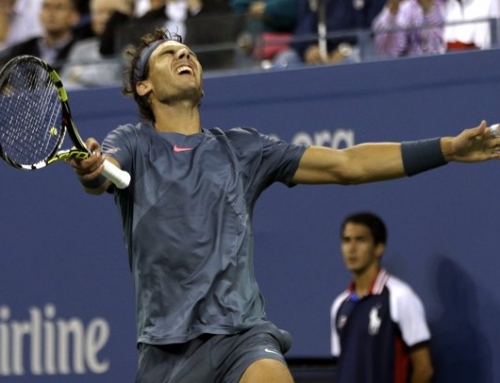 What? Not a provocative enough title?
What? Not a provocative enough title?
Most people were surprised when Nadal came back on tour in South America. Of course, Nadal is king of clay, but they thought, even with a weakened field, that he would struggle some. After all, Juan Martin del Potro took off a comparable amount of time (roughly February of 2010 to October of 2010, then the rest of 2010), and it took him about a year to get himself back to the top ten. To be fair, del Potro hurt his wrist and that required surgery while Nadal hurt his knee and didn’t get surgery. In theory, he could still hit balls.
Nadal would go on to reach every final of every tournament he played except one: Wimbledon. Nadal had played so much tennis from Monte Carlo to the French Open that he opted to rest, and didn’t practice that much. That rust did show. What this demonstrates is that Nadal knows how to prepare for a comeback.
In this streak, he won every hard court event he played in which included Indian Wells, Montreal, and Cincinnati beating Novak Djokovic en route.
Heading into the US Open, Nadal seemed like the man to beat, although some still held out hope that either defending champ, Andy Murray, or previous defending champ, Novak Djokovic, or even the champ from 2009, Juan Martin del Potro, might still be better than Nadal.
Such hopes were tied to two things: Nadal’s knee and that these players play best on hard court surfaces. It didn’t seem tied that much to how Nadal was actually playing.
In particular, since Nadal has begun playing on hard courts, he has upped the level of aggression. Roger Federer said that Nadal isn’t playing that much differently, just that he is playing his opponents like he plays Roger. Federer said that Nadal would sometimes be more passive against other opponents.
In particular, Nadal is willing to aim for the sidelines much quicker. He wants to crowd the baseline. And, as he did in the French, he wants to take a righty’s inside-out forehand and hit it down the line, something many players are fearful of.
Nadal sailed through the early rounds, beating Harrison and Dutra da Silva handily, and having a mild struggle against Dodig. Nadal’s biggest challenge came in a very humid night match against Kohlschreiber. Kohlschreiber was able to attack Nadal with angled forehands which opened up the court which he hit into.
Despite that, Kohlschreiber struggled to break serve (and, in fact, didn’t). Although Nadal’s first serve usually comes in around 110 mph, the lefty spin seems to bedazzle opponents, who sometimes net the shot.
Nadal went back to his winning ways with a beatdown of surprise quarterfinalist, Tommy Robredo, who really offered little resistance to Nadal. Robredo only won 4 games in that match.
The semifinal was a little better, but it was a weirdly passive-aggressive Gasquet. Passive in that he was willing to get into long rallies hoping for an error, and aggressive when he finally decided to go for a winning shot. Nadal didn’t look particularly sharp in this match, but he primarily had to avoid making too many errors, and that was enough to win the match. Gasquet wasn’t making enough of his power shots.
Djokovic also had a fairly comfortable opening four rounds. An easy win against Berankis, then nearly dropping the opening set to Becker, then easy matches against Sousa and Granollers. Djokovic finally dropped a set against the wily veteran, Mikhail Youzhny, before coming back with a 6-0 fourth set. Then, he was pushed to 5 sets by Stan Wawrinka.
All in all, Djokovic is still striking the ball pretty cleanly, so he goes into the final playing decent, if not outrageously good ball. And, of the two finalists, Djokovic has had to work harder to reach the finals, though mostly, that’s due to Nadal’s style not matching well with almost everyone.
The finals match favors Nadal for quite a few reasons, even if the match is likely to be close. First, Nadal has beaten Djokovic in their past two encounters (Montreal and Roland Garros). To be fair, Djokovic didn’t seem on his game in Montreal (his serve was shaky) and the French Open frankly could have gone either way, though Nadal had played the better match regardless.
Djokovic did beat Nadal back in Monte Carlo, but Nadal would say that his game wasn’t quite up to par then. But mainly, Nadal is on a win streak, and has looked very sharp.
This isn’t to say Djokovic doesn’t have a chance, because clearly he does. It’s just that if I expected one player to play poorly, it would be Djokovic, not Nadal. Conditions have been breezy, and this affected Djokovic last year in the semis. Meanwhile, I’ve seen Nadal play in a windstorm and handle conditions pretty well.
So, edge to Nadal!





![[US Open, Semis] Djokovic and Nadal to play US Open final once again](https://www.essentialtennis.com/wp-content/uploads/2013/09/20130907nadal-500x383.jpg)
![[US Open, Day 11, QF] Wawrinka upsets Murray in straight sets to make first Slam semi](https://www.essentialtennis.com/wp-content/uploads/2013/09/20130906wawa-500x383.jpg)
![[US Open, Day 10, QF] Nadal shuts out Robredo to reach semis](https://www.essentialtennis.com/wp-content/uploads/2013/09/20130905nadal-500x383.jpg)